Ecommerce Advantages and Disadvantages for Businesses and Customers
Author & Editor
Senior Software Engineer
Published on: Mar 27, 2023 Updated on: Jul 23, 2024

Table of Contents
The survival and growth of businesses these days lie in the presence of a robust ecommerce platform. So if you haven’t considered or started building one, then it’s high time you read up on our take as a web design and development company on which fits your needs and business best.
The most successful businesses know the disadvantages and advantages of ecommerce and strive to balance them to maximize revenue. Read up and learn more about it here:
What is ecommerce?
Electronic commerce or ecommerce, is the process of selling and purchasing products or services over the Internet. This also involves online data and money transactions to complete the sales. Without any brick-and-mortar store, these online transactions can easily be done by anyone in every corner of the world.
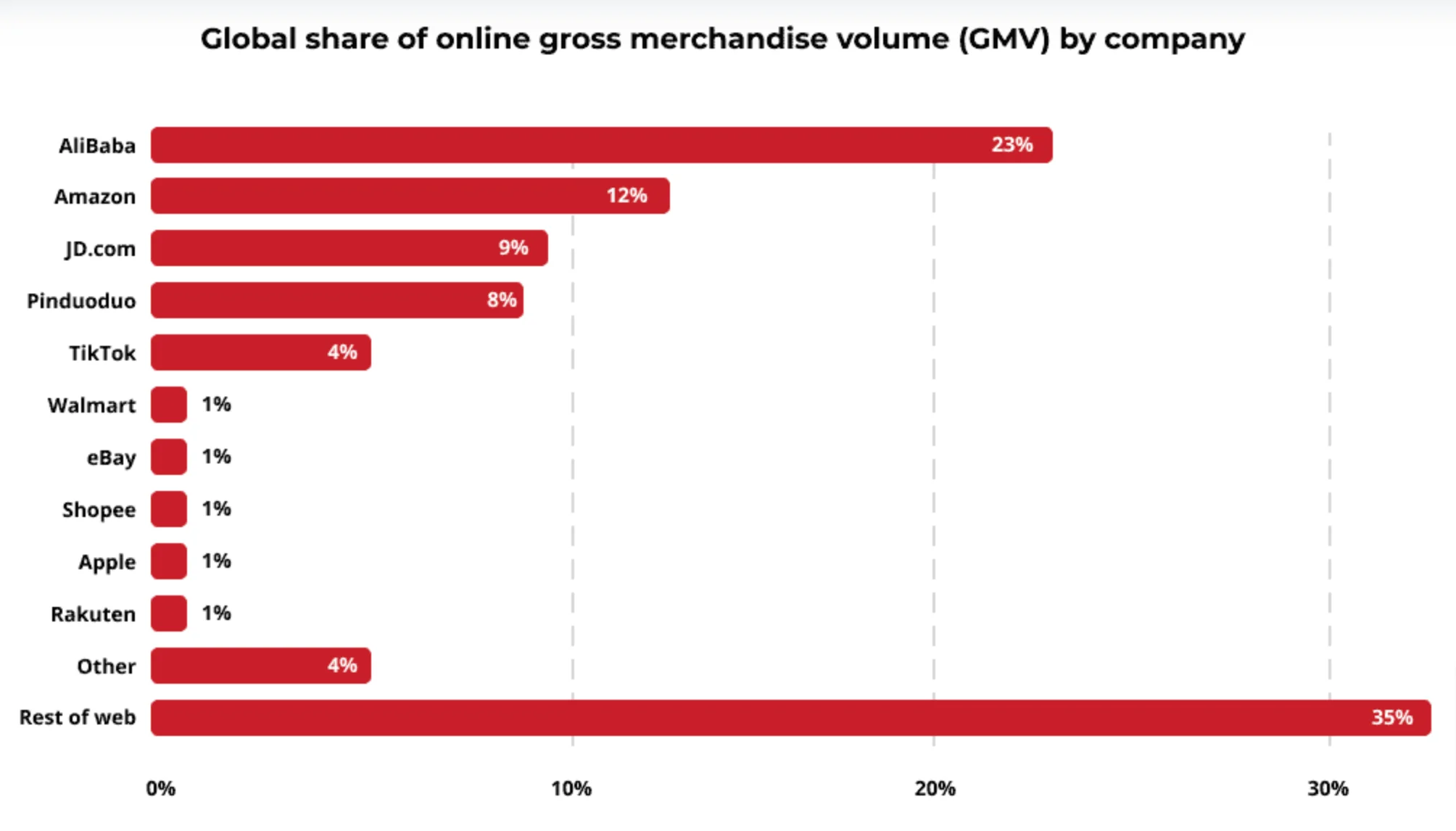
You may be familiar with online marketplaces like Lazada, Shopee, Amazon, eBay, Carousell, or Metrodeal where small to huge businesses sell their products through this online public platform.
Marketplaces and owned ecommerce have their own distinctive advantages to satisfy particular features and demands of your business, and getting them established on is critical so you don’t have to make drastic changes that could cost you a lot of money.
Whether you’re working with a templated marketplace, or partnering with website developers to create your own ecommerce site, having an ecommerce frontend template can be very useful.
It’s essential to weigh the pros and cons of deciding between a marketplace vs your own ecommerce before deciding on the platform to develop for your brand.
Types of ecommerce
There are many different transactions ecommerce can offer your business. Below is a list of the 6 types of ecommerce models to help you understand which one best fits your business needs.
- Business to Consumer (B2C). Is the most common type. On this platform, consumers avail of products or services from your business like buying a shirt if you’re in fashion retail, or booking a meal reservation, if you’re in a dining establishment.
- Business to Business (B2B). This is where transactions between businesses can be done. It usually involves the trading of raw materials or products that will be manufactured or services that have a particularly long sales cycle.
- Consumer to Consumer (C2C). C2C platforms allow consumers to use online selling platforms to market products to other consumers and buy products from another platform user. Online C2C platforms include Etsy, eBay, and Craigslist.
- Consumer to Business (C2B). This is when customers sell products or services to businesses, flipping the traditional model. It extends beyond physical products to include items like image rights or freelance services.
- Business to Administration (B2A). Is when companies sell services or products to government agencies, also known as business-to-government (B2G) ecommerce. In B2A transactions, sales cycles are longer due to bureaucracy and budget constraints. Though it takes time to navigate, securing a few government contracts can sustain a profitable business, unlike needing many customers in a B2C model.
- Consumer to Administration (C2A). For this type of ecommerce transaction, customers interact with government agencies instead of businesses. This is similar to B2A companies, but the transactions are with government agencies rather than companies.
Understanding the nature of your business will help you decide which type of ecommerce platform is best for your business. Factors such as your target market, products or services, and desired level of control will determine whether a B2B, B2C, C2B, or another model suits your business goals.
The rise of ecommerce
During the 2020 quarantine, global ecommerce sales soared by 77% compared to the previous year. In 2021, the global population shited to become online shoppers, equating to one in four people using online shopping solutions.
With approximately 2.64 billion people expected to shop online in 2024, these numbers are set to grow even further. Ecommerce's numerous advantages continue to drive this growth, with brands leveraging it for business expansion.
To aid ecommerce businesses in this growth, digital marketing plays a crucial role. It helps attract customers and enhances brand value, leading to significant revenue growth. Before launching your online platform, it's essential to understand the intricacies of ecommerce, whether you're a small business or a large brand.
The advantages of ecommerce
Small and big-scale enterprises alike are scrambling to invest and optimize their ecommerce platforms thanks to the many advantages they offer.
Ecommerce enables smarter business operations by leveraging tools like data analytics to understand customer behavior and test innovative ideas.
However, the most significant benefit of ecommerce lies in its ability to provide a seamless and enjoyable transaction experience for customers, fostering brand loyalty and sustainable business growth. If you haven’t quite made up your mind about ecommerce platforms and adapting them for your businesses, the following advantages below might just give you that push you need.
1. Ecommerce has limitless revenue potential
One key benefit of ecommerce is the 24/7 availability of online stores, giving you a competitive edge over traditional brick-and-mortar stores with limited hours. This accessibility attracts more customers and boosts revenue.
Think about your target audience—those with irregular schedules or busy lifestyles. An ecommerce store caters to their needs, allowing them to shop anytime, anywhere.
Even late-night shoppers are accommodated without the need for overnight staff. Automate ordering processes to provide instant confirmation, ensuring customer satisfaction.
Additionally, ecommerce eliminates the hassle of waiting in queues and searching through shelves. Customers can easily browse, search, and order products online, leading to faster transactions and increased sales.
If you play your cards right, you have the opportunity to sell more products and earn more profit compared to a physical store.
2. Ecommerce will enable you to reach more customers
Ecommerce offers the advantage of reaching thousands of new customers daily, unlike traditional brick-and-mortar stores limited by location. With an online presence, your potential client base becomes global, eliminating geographical boundaries.
Customers from anywhere in the world can access your products or services through your ecommerce website. This not only expands your reach but also simplifies the shopping experience for them, eliminating the need to travel to a physical store.
Going digital can significantly boost your customer base and revenue. According to Entrepreneur, over half of the businesses experienced substantial growth after establishing an online presence. Additionally, the rise of mobile technology further fuels ecommerce growth, with mobile commerce sales projected to reach $2.5 trillion by 2024.
As online shopping continues to increase in popularity, it's essential for businesses to prioritize their online presence to stay competitive. Instead of investing in brick-and-mortar locations, consider allocating resources to develop and market your online store for long-term success.
3. Ecommerce helps reduce operational costs
Opening a physical store can be expensive, with costs for rent, furnishings, equipment, and staffing. This ties you to a specific location and demands significant upfront investment and ongoing expenses.
That's why many start-ups and small businesses opt to go online instead. Setting up an ecommerce business is far more affordable. You can either build a custom website for a nominal fee or use a third-party ecommerce platform, which offers pre-built functionalities. This means you can start selling online quickly and with minimal costs.
Regardless of the platform you choose, one of the biggest advantages of online businesses is their lower operational costs.
4. Ecommerce can adapt to your needs
An ecommerce website is up and ready within a few days if you choose a hosted solution. Of course, a custom-built website will take longer.
You can update your product offers, display, and promotional materials on an ecommerce site nearly instantaneously. In a real store, you’ll have to physically shift items around, which takes longer. An ecommerce site is incredibly adaptable, allowing you to respond to changing client wants as well as changing corporate demands.
Finally, an ecommerce business allows you to be flexible. As the proprietor, you may operate from any location with an Internet connection. You might not even need an office; you can work from home!
5. Ecommerce can manage multiple purchases
Physical stores can usually only serve a few customers at once, while online businesses can handle many orders simultaneously. This means no waiting in line for customers, which is a big plus for those in a hurry.
One of the best things about ecommerce is its ability to handle a large influx of customers, especially during busy times like holidays. With online shopping, placing an order is as easy as clicking a button, so you can serve many customers quickly and efficiently, without any delays.
6. Ecommerce automation can help reduce human errors
The bulk of shop activities are incorporated into your ecommerce platform and are programmed to run automatically. It’s fantastic since it reduces the possibility of a mistake, such as a lost order or an inappropriately charged payment. There is a benefit in that they will not confuse or annoy your consumers, resulting in creating a terrible reputation.
Online platforms offer ways to sell the product, and not just tell details about it. Product descriptions can grow casual shoppers into revenue-generating buyers.
7. Ecommerce makes in-depth product description available 24/7
How much information about an item can a physical retailer give its customers? Certainly not much. Customers select whether or not to purchase a product based on the packaging and a brief description offered by the manufacturer.
Without being restricted by just a few geographical locations, your business is awake and running 24/7. Ecommerce sites never shut down for it is designed to cater to customers from any corner of the world, operating in different time zones.
So even if you are not physically available or don’t have 24-hour customer support, your sales aren’t restricted. You can automate your site to enable your customers to avail of your products and services any time of the day.
Ecommerce is also devised to have automated customer support to assist your customers anytime through artificial intelligence (AI) processes such as chatbots, live chats, and virtual assistants.
When you purchase online, however, you receive a more extensive product description sometimes with multi-angle shots, tips, unboxing videos, and a list of numerous similar items. Furthermore, online purchasing allows you to read product reviews left by other customers. All of this information contributes significantly to a better-informed buying decision. It is one of the most significant benefits of ecommerce,
Let's check out a bra product page from Wacoal, a brand we’re currently working with. The page provides users with key information to help them make a decision, including price, available colors, a brief product description, and available sizes.

Ecommerce business provides more information about your products and services to your customers. You can also feature customer reviews, usage videos, product guides, and social validation. These details can logically reason out the product’s price and create the impression of authenticity.
8. Ecommerce offers easy access to customer data
One of the finest ecommerce benefits is the ease with which you may obtain data for consumer analysis. Most individuals are hesitant to give their email addresses or postal codes to physical stores. Through ecommerce, you may legally obtain your customer’s name, postal address, email address, and phone number. This implies you have at least three distinct ways to interact with your customers and build a relationship with them.
An important caveat you should consider in this regard is that: The ability to collect data from your customers requires responsible handling of their personal information. For example, here in the Philippines, your collection and handling of data should strictly comply with the provisions stated in Republic Act 10173 or the Data Privacy Act of 2012.
In a nutshell, businesses and other entities requesting information from their end-users should ensure that:
- Data should always be gathered with consent.
- Lawfully handle the data based on the requirements in the Data Privacy Act of 2012.
- Ensure the confidentiality of the gathered data.
Businesses need to comply with other data privacy regulation bodies like GDPR (General Data Protection Regulation) and CCPA (California Consumer Privacy Act). Building trust with customers by showing commitment to security is important.
9. Ecommerce businesses are scalable
One of the advantages of ecommerce is the ease with which the platform can be scaled. You may boost your ad budget when people are clicking and buying without having to worry about keeping up with demand, especially if you dropship.
You may use analytics platforms such as Google Analytics () and MS Clarity to learn about the customer behavior and demographic data of your customers. With this data, you can optimize your marketing strategies, promote a new product, and keep in touch with your customers. Note that you have to ensure confidentiality of the gathered data by using it only for official purposes and data should be gathered with the customer’s consent.
With our brand, we get a glimpse of our demographics from Google Analytics.
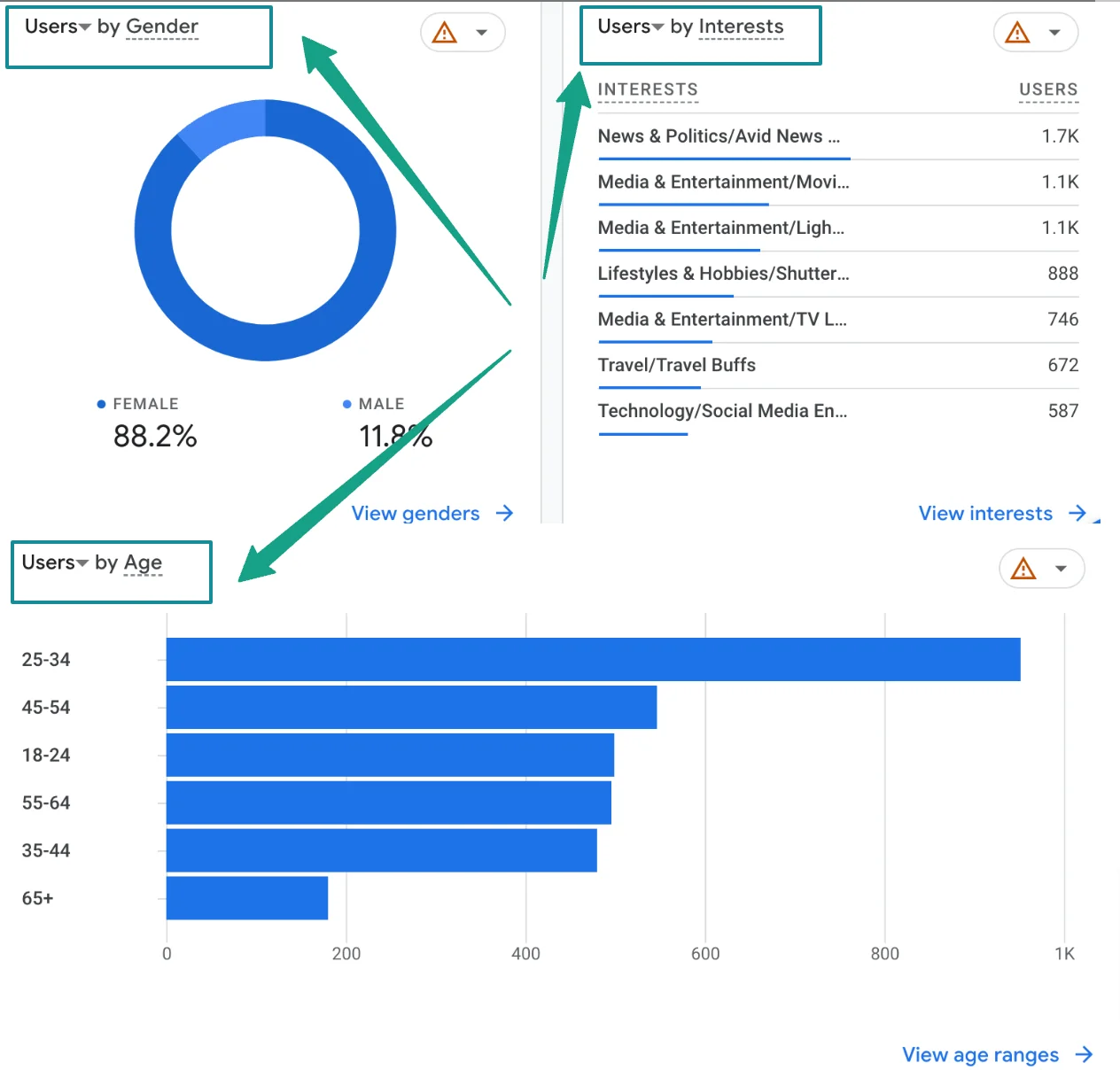
We also learn which product is more popular, most viewed and eventually bought given a time period using GA4.
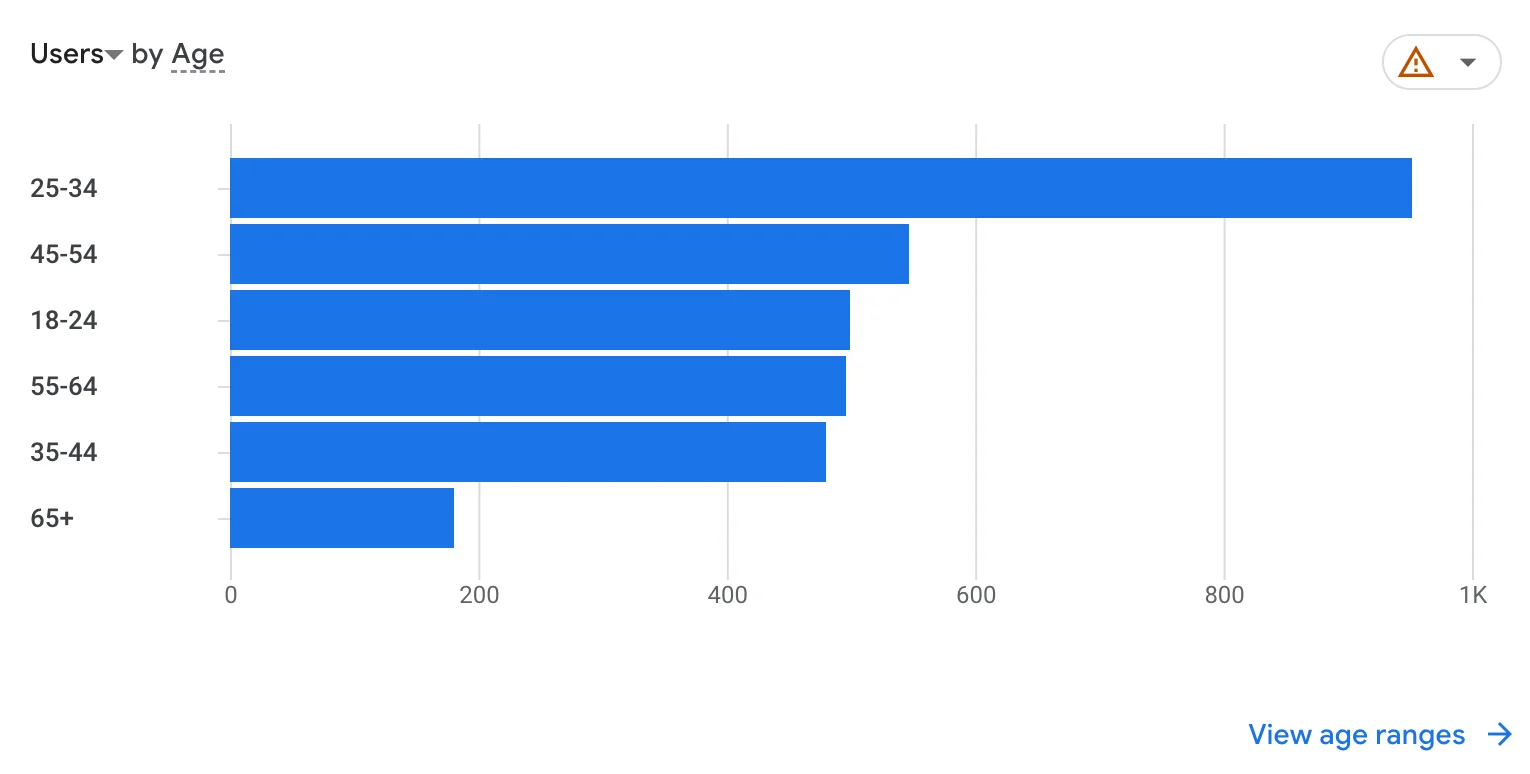
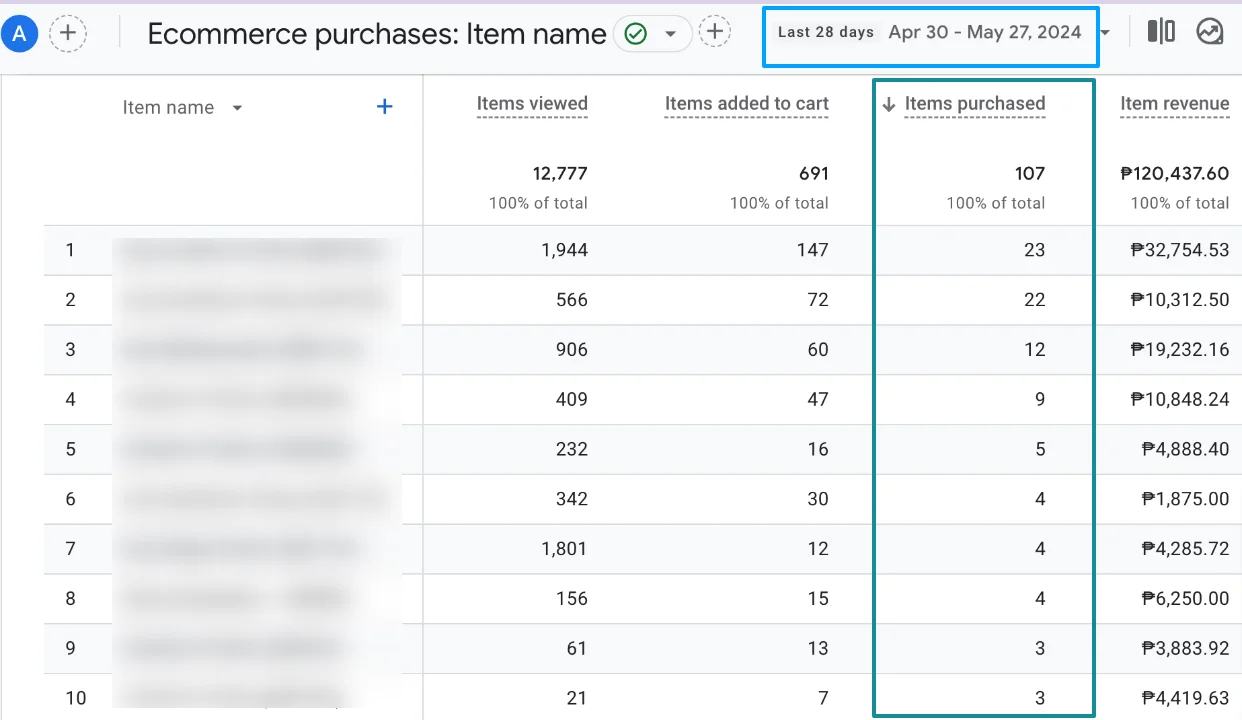
With ecommerce business, you may add new items to your site without having to worry about shipping or physical inventory, allowing you to expand swiftly.
10. Ecommerce performance can be tracked
With the aid of analytics, you can gather information about a customer and gain a clear knowledge of their demographics, including their gender, age, hobbies, the kinds of products they prefer, and much more. In addition, you can easily track which products are performing well and which aren’t. You may design the shop to automatically offer consumers the goods they are most likely to be interested in, based on these data.
Analytics is a great way to explore business opportunities and figure out what you need to change to improve your return on investment.
With one of our accounts, we use GA4 to learn about our users, including their location, gender, interests, age, and language. This helps us optimize the website and prioritize which products to promote, all while respecting data privacy.
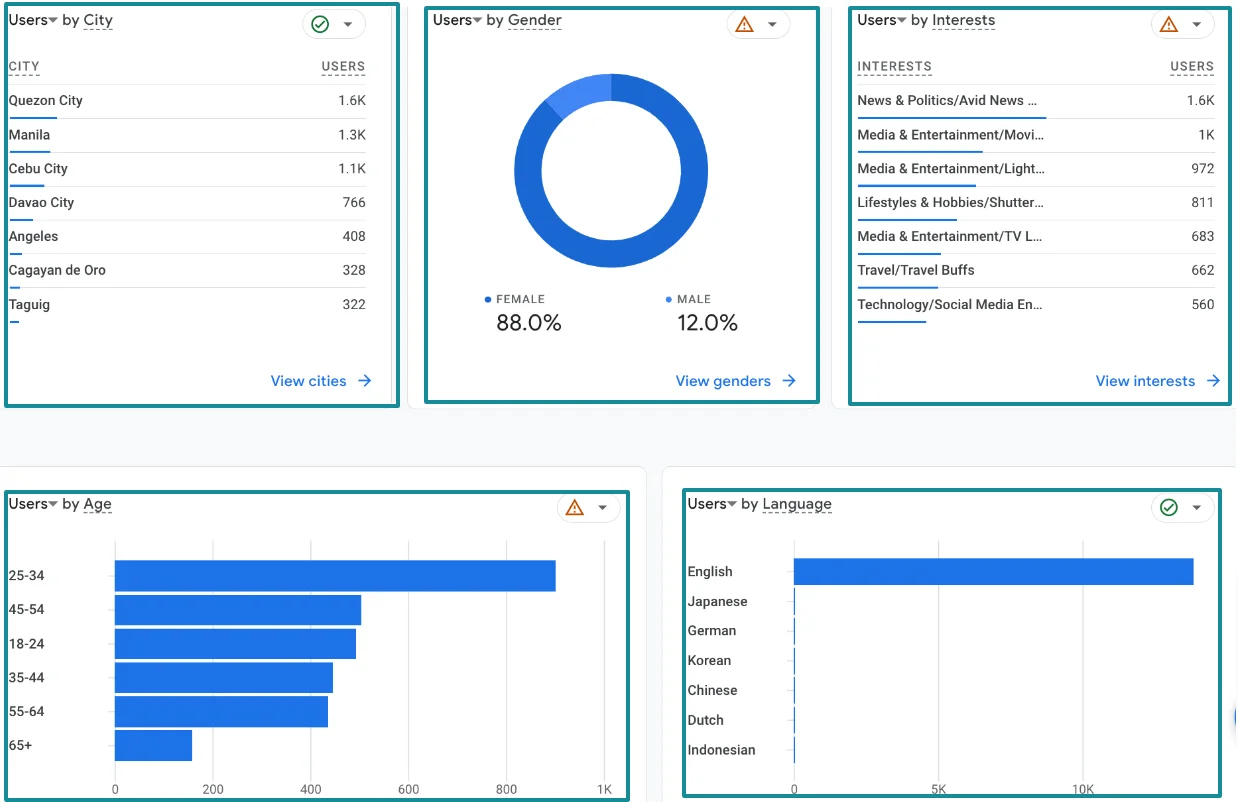
11. Offers payment flexibility.
Ecommerce’s varied payment options feature is a great benefit that allows your customers to pay in different ways like cash on delivery, debit or credit card payment, electronic bank transfers, mobile or prepaid card payments, and e-wallets. These varied payment methods not only ensure safe and quick processing check-outs but also increase your clientele and turnover.
Let’s see these available payment options in Soko Glam, an online beauty store as an example.
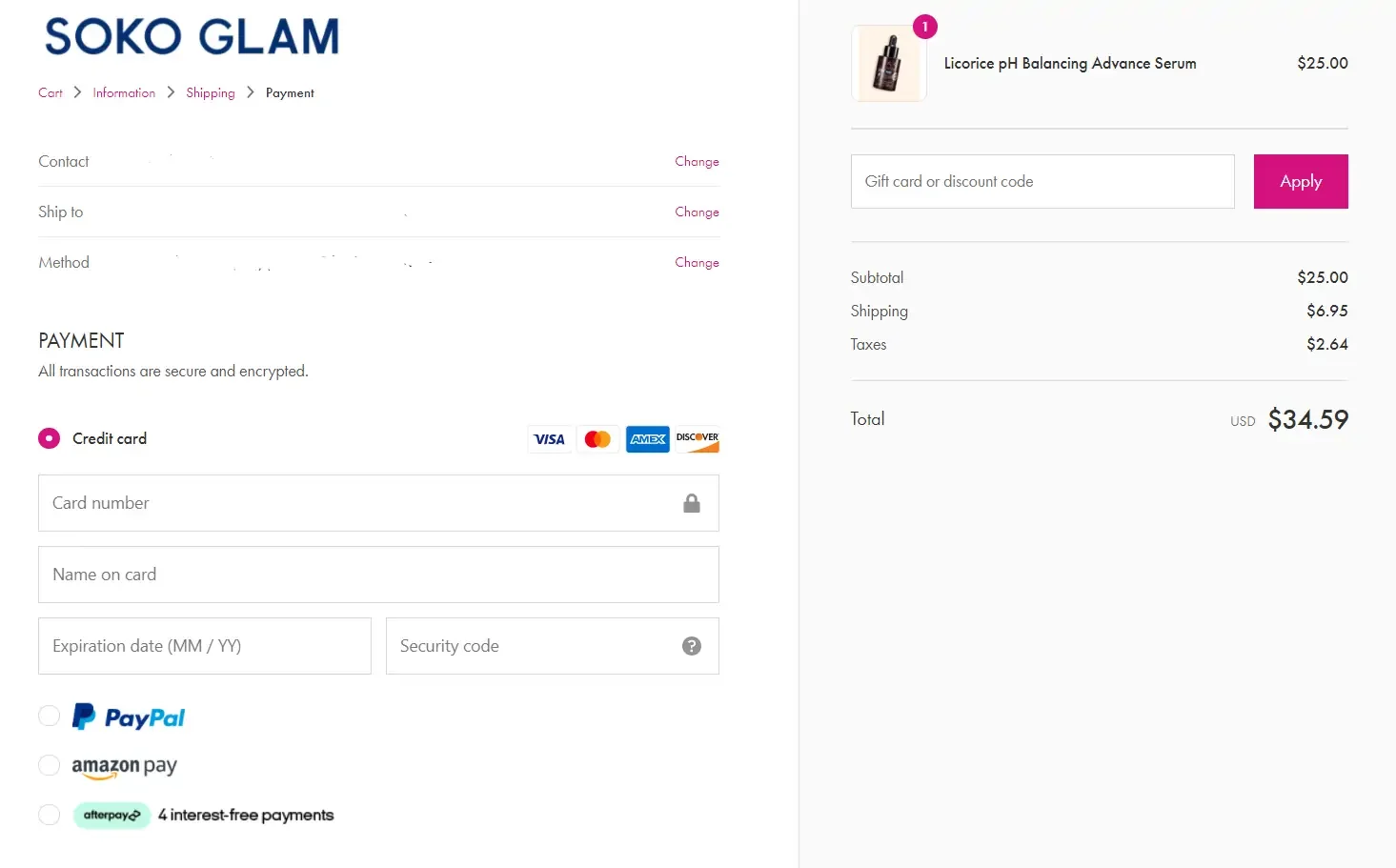
Figure 2. Soko Glam Payment Options. From credit cards to e-payments, this shop provides flexibility for their customers to finish purchasing their products.
Proposing varied payment options translates into more transactions and a bigger turnover.
Catering to your customers’ preferences raises the probability that they will have more transactions. Aside from that, it also caters to customers who prefer to pay in a different currency without having a long manual process of currency conversion.
12. Ecommerce is convenient and safe.
Convenience is just one of the many advantages of ecommerce.
Studies have shown that convenience is one of the most important decision factors for consumers. With just a few clicks from the comfort of your clientele’s home or office, your products are on their way. The bottom line is that your clients demand convenience so if your business is not convenient enough to meet their needs, they’ll probably go off looking for better shops.
READ ALSO: A Complete Guide on Ecommerce Security and Protection
To wit, ecommerce is not a perfect solution that is invincible to outside factors. However, despite its inherent weaknesses, it does offer a lot of redeeming value for your business. A balanced knowledge and understanding of both will help you decide and act accordingly.
The disadvantages of ecommerce
While it may initially appear that ecommerce could solve some of your business problems, an online store has its own set of unique flaws and vulnerabilities.
These are problems specific to this operational model that you need to be aware of to avoid typical pitfalls. Learn some limitations of ecommerce below:
1. Ecommerce is extremely competitive
Ecommerce has been quickly expanding in the Philippines, fueled mostly by online marketplace activities. However, in contrast to other nations, the Philippines continues to lag in terms of ecommerce development.
To date, the Philippines’ ecommerce reach has yet to be as established as that of other nations, leaving plenty of room for expansion in 2021. In terms of real world statistics, numerous businesses have only just begun to develop their ecommerce platforms in 2021.
Take a look at the projected ecommerce growth from 2022:
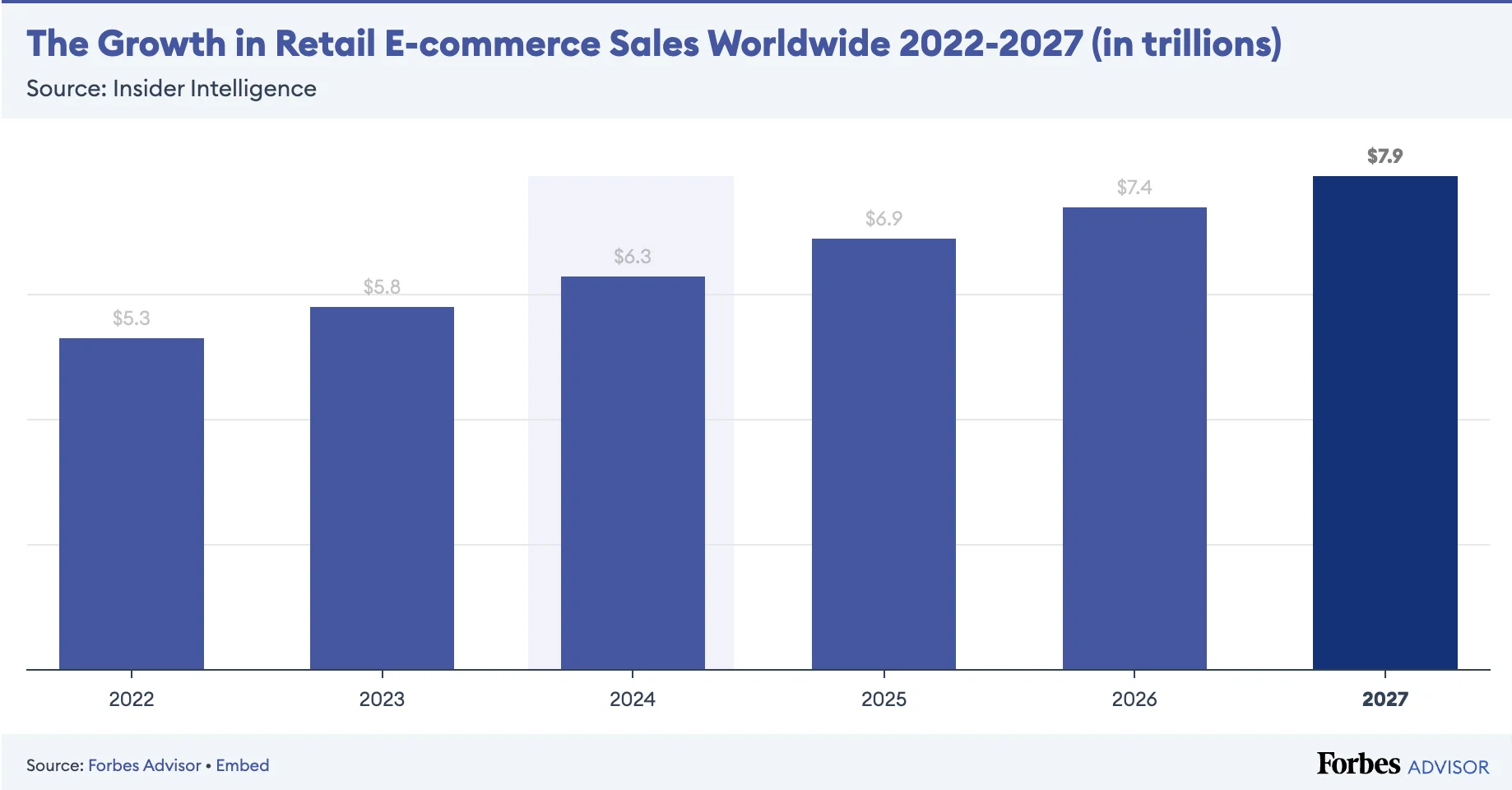
In the Western part of the world, discussions on ecommerce competitiveness won’t be complete without mentioning Amazon. Amazon isn’t the only giant making it difficult for small businesses to thrive, there’s much competition in practically every market.
In truth, the finest niches are usually the most competitive. This is why so many businesses are drawn to them. However, the more competitive a specialized field is, the more expensive its advertising and marketing needs would also be.
There are companies whose ad budgets ensnare the high-profile phrases on Google Adwords and drive up the cost of clicks to absurd levels. Some shops can ship faster or offer free shipping. And then there’s the competition on who has the lowest costs.
Differentiating oneself from the competition entails discovering new marketing views and developing a strong brand identity. With so many businesses competing for the same audience, beef up your ecommerce practices with local SEO strategies so you can gradually move ahead.
2. Ecommerce is susceptible to errors that sacrifice operational hours
The worst ecommerce disadvantage is when no one can buy from your business because your website has crashed. You can’t make a sale if your website keeps on crashing.
For example, if you pay the minimum price for hosting and have a rush in traffic from a high-converting ad, your site would most certainly crash.
No customer wants to visit a website with a complicated or dull navigation menu.
If your customers don’t find what they are looking for easily, then they might bounce from your website without making any purchase.
Your visitors will leave your website if it is sluggish, ugly, badly designed, or does not work properly. An ecommerce firm cannot exist without a powerful website.
To save your online business from a sluggish performance, make sure your website is user-friendly, easily navigable, and loads at a lightning speed.
With Google's mobile-first policy and focus on user experience, we ensure website performance improves and reaches a passing grade. Here's the performance before we started optimization:

Here are their scores since our last optimization:

3. Ecommerce website could encounter security issues
Every time a consumer enters their information onto a website, they incur the danger of identity fraud and other risks. If your website does not persuade visitors that the checkout procedure is safe, they may be put off from making a purchase.
Businesses, on the other hand, are vulnerable to phishing attempts and other types of assaults. If one of your workers stumbles on a malicious link, it might undermine the operation of your website, financial information, or worst of all, the information of your customers.
When collecting this type of sensitive information, suitable protections must be in place to eliminate the danger of security fraud and phishing attacks.
Whether you start your online store on your own or with the help of an agency, you need to make sure that it is set up to handle secure transactions (with SSL) to avoid fraud.
4. Ecommerce lacks personal touch and face-to-face relationships
This issue might be of particular importance to customers shopping for specialty items, as they might wish to talk to an expert in person regarding the best product for their needs. A strong hotline cannot substitute face-to-face engagement with a specialized sales representative. In addition, many clients enjoy clothes shopping and desire to try on the goods before deciding to buy.
The chance to chat with a sales assistant about your requirements and difficulties is frequently more efficient than attempting to locate or compare items on your own. The ability to look your consumer in the eye and convey the worth of your items is the most significant loss.
5. Ecommerce entails complex taxation guidelines
There is presently no specific legislation in the Philippines that mandates the taxation of ecommerce transactions. In terms of taxation, the National Internal Revenue Code (Tax Code) does not distinguish firms having a physical presence and those with a virtual existence. In this regard, internet transactions are taxed in the same manner as brick-and-mortar transactions. Unless a taxpayer qualifies for an exemption, he or she is required to pay taxes.
As a business owner, you may be eager to offer your items all over the world. It does, however, imply that you must adhere to the taxation requirements in each country where you intend to supply. Aside from the time required to study them all to ensure compliance, you will need to address the issue of cost-effectiveness for your business.
This has the potential to complicate accounting, compliance, and taxation.
Best practices to maximize advantages
Now that you know the roles of ecommerce in your business, it’s a great challenge to maximize its advantages in launching your online selling platform. But worry not, here is a quick sketch to make full use of and derive maximum benefit from ecommerce.
- Use automation and content marketing to engage and attract your customers that aim to convert them from leads into customers.
- Connect with your customers through social media. This grows awareness about your brand and generally improves your leads and sales.
- Address your audience’s feedback for continued business growth.
- Analyze consumer demands and market competition to ensure that your investment is cost-effective to yield greater returns.
Key takeaways
Armed with a basic understanding of the benefits and drawbacks of ecommerce businesses, you should be prepared to start your own. Despite the disadvantages, ecommerce has become so popular that most brick-and-mortar merchants have established ecommerce platforms to supplement their physical operations.
- Ecommerce is not a fleeting trend; it is the future and a result of the aforementioned technological advancements.
- You’ll need to make a serious commitment to develop a fantastic website and a strong online presence. You must be attentive to the demands of your company and its customers.
- Your business needs to identify marketing tactics that will help differentiate itself from the competition and establish itself as a respected brand.
Are you struggling to find the right ecommerce strategy for your business? We’d love to hear from you! Drop the Propelrr team a line over at our Facebook, X, or LinkedIn pages.
For tips on ecommerce development for your businesses, make sure to subscribe to the Propelrr newsletter, and we’ll deliver them straight to your inbox.
